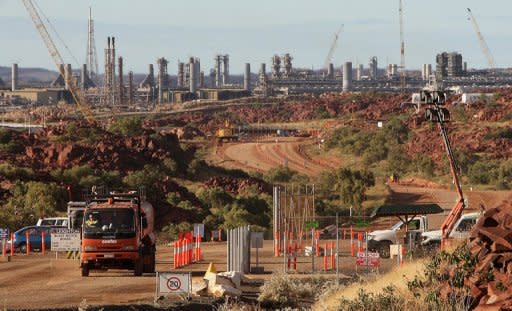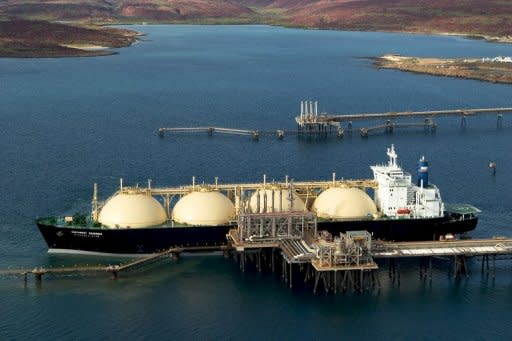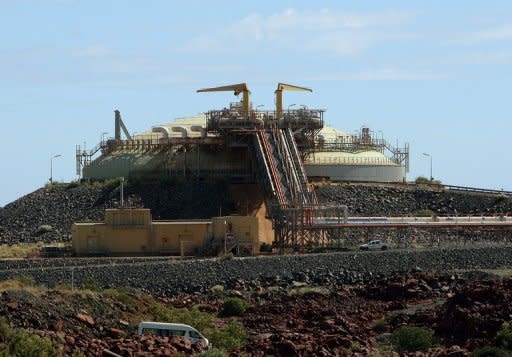Australian gas rush set to overhaul Qatar's lead
Australia is set to become the world's biggest liquefied natural gas producer, with analysts predicting it will overtake Qatar by 2020 as it unlocks reserves that could last more than a century. Seven of the world's 10 major LNG projects are under construction Down Under, with Aus$176 billion (US$183 billion) of private Australian and foreign investment in gas projects since 2007. "The projects already under development will take us ahead of Qatar. It's just a case of when that happens," Wood Mackenzie analyst Chris Graham told AFP. Analysts expect Australia to pip the small Gulf emirate, which holds the world's third-largest gas reserves and last year saw LNG production capacity rise to 77 million tonnes per annum (mtpa), by 2020. But the government is hoping it reaches the target sooner, with China's demand for LNG growing by almost one-third last year, while India's import capacity was projected to triple by 2015. Australia is already the fourth biggest source of LNG in the world, with three export-operational projects -- Western Australia's North West Shelf and Pluto projects, and Darwin LNG in the Northern Territory. Indonesia and Malaysia are the second and third largest. But based on projects that are already committed or under construction, Australia's LNG exports -- of 18.9 mtpa worth Aus$11.1 billion in 2011 -- are expected to hit 63 mtpa by 2016-17. Beyond these, there is a suite of other proposals that if developed could increase output above 100 mtpa, and potentially position Australia as the world's largest LNG exporter by the end of the decade. "By 2017, based on proposed and committed new projects, Australia's LNG production capacity is projected to quadruple," Resources Minister Martin Ferguson said. Australia's abundance of natural resources and proximity to commodities-hungry Asia helped the economy avoid recession during the global financial crisis, thanks to exports of coal and iron ore. LNG is the newest potential earner from Asia's development, with the vast majority of exports already sold to Japan (69 percent in 2010) and with sales contracts to supply China and South Korea also in place. "Australia is a very popular source for East Asian buyers because of low political risk and they are comfortable dealing with operators in this country," Graham said. "Sure, it is a high cost environment but resources in Australia are huge and opportunity from a resource perspective is obviously there and it ultimately comes down to competing projects elsewhere in the world." Adrian Wood, an analyst at Macquarie Securities, said Australia was likely to overtake Qatar by 2020, but only just, with strong competition from the United States and also potentially parts of Africa. The Australian government expects LNG exports to expand rapidly as developing countries enjoy economic growth and move away from using coal to gas for electricity generation. "Natural gas is increasingly the fuel of choice for developing economies because of its versatility and lower carbon emissions compared with other fossil fuels," Ferguson said this month. He also noted the challenges of providing adequate skilled labour and the infrastructure needed to deliver projects that export LNG -- natural gas that has been cooled to liquid state to make it practical for transportation. As a Bureau of Resources and Energy Economics report released his month noted: "The principal challenges for Australia's LNG export sector is that projects have relatively high costs, slower construction times and larger capital expenditure." The costs, partly due to the remote locations of offshore gas fields, have lumped some Australian projects with capital costs of about Aus$3-4 billion per million tonnes of annual capacity -- well above recent projects in Papua New Guinea and Angola, the report said. This compares with a capital cost of less than US$1.7 billion per million tonnes of annual capacity for the Angola LNG project. "These costs are the highest in the world and are attributed to high labour and other input costs and a high Australian dollar," the report said. "Counterbalancing these relatively higher costs are Australia's stable system of government, high levels of personal security, well-defined property rights, and established fiscal and regulatory frameworks that encourage foreign investment."




